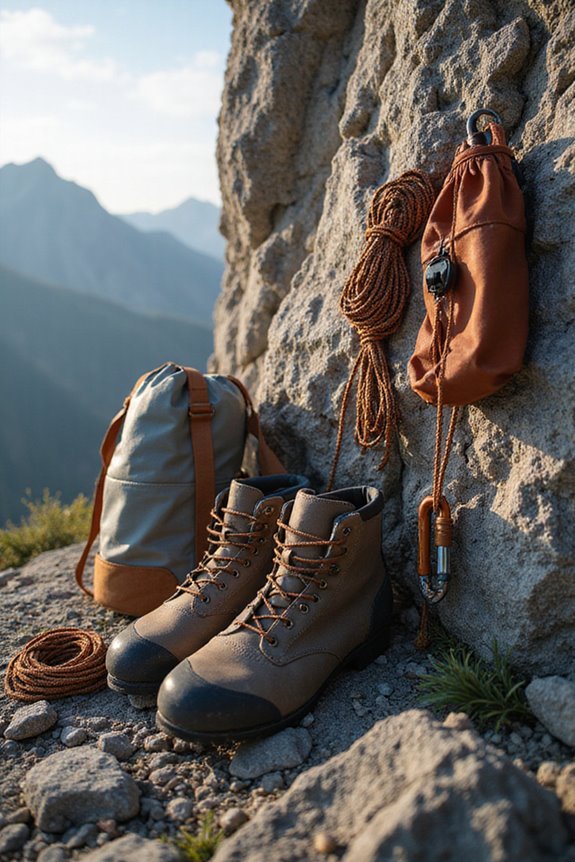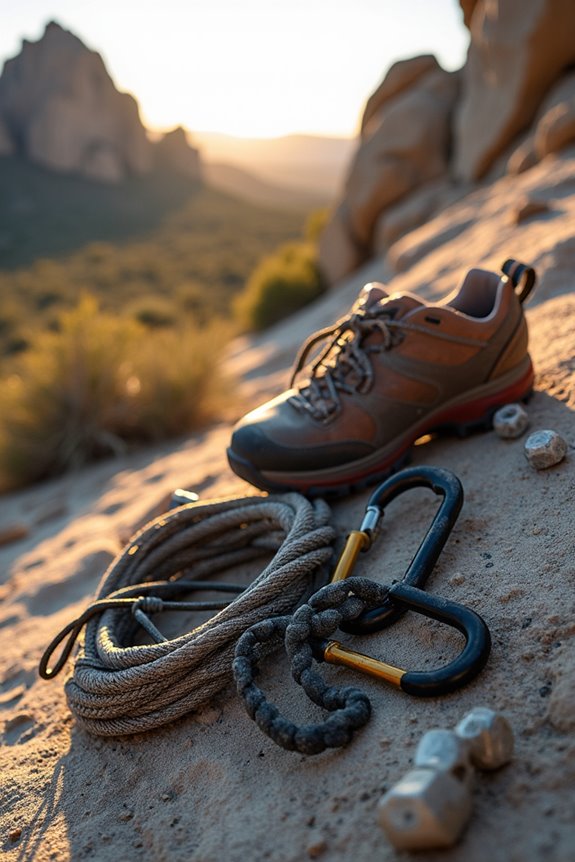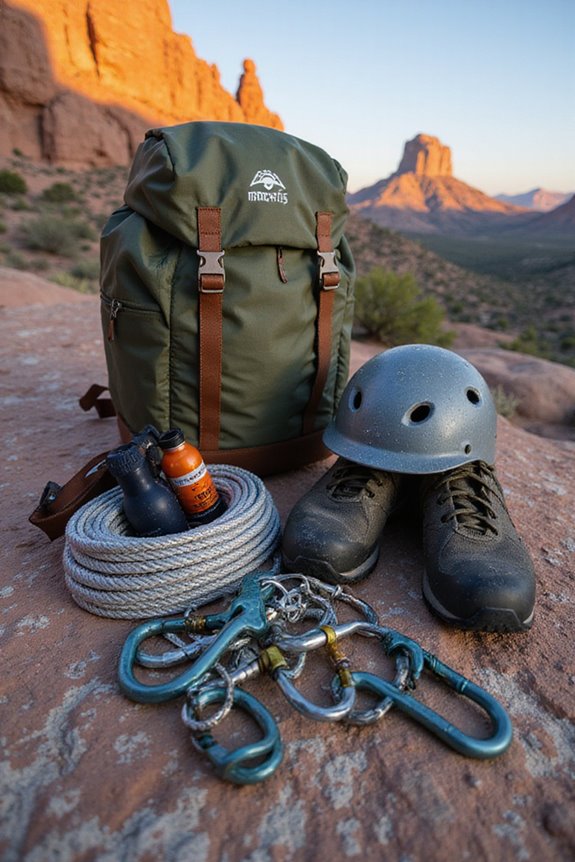Choosing mountain climbing is an exciting adventure! First, we need to understand the climbing grades that match our skills. Next, let’s get the right gear—good boots and a helmet are non-negotiable. Physical training is key! We should build our strength and endurance! Planning our route, weather checks, and sharing our itinerary keeps us safe. And let’s not forget the mental game; staying resilient is crucial when the mountain tests us! Stick around, and we’ll explore more about this thrilling journey!
Key Takeaways
- Assess your climbing skills against different grading systems to choose appropriate routes for your experience level.
- Select gear based on weather conditions, ensuring you have essential equipment like helmets, ropes, and navigation tools.
- Develop physical training plans focusing on cardiovascular endurance, strength conditioning, and core stability to build climbing fitness.
- Plan your climbing itinerary by mapping daily mileage, elevation, and potential camp spots, while monitoring weather for safety.
- Cultivate mental resilience and effective communication with your climbing team to adapt to challenges that may arise during your adventure.
Understanding Climbing Grades and Difficulty Levels
When we talk about choosing a mountain climb, understanding climbing grades and difficulty levels can feel like traversing a maze—especially with all the different systems out there! Those climbing terminologies can sound intimidating, but they’re key to what we’ll tackle next.
The Yosemite Decimal System, British Grading System, and French Alpine Grading System all have unique ways of classifying climbs. From the straightforward numerical grading in Australia to the variance in the UK’s adjective rankings, grade comparisons can get wonky, but that’s the beauty! Embrace the adventure, and let these systems guide us in discovering our limits.
Essential Equipment and Gear Considerations
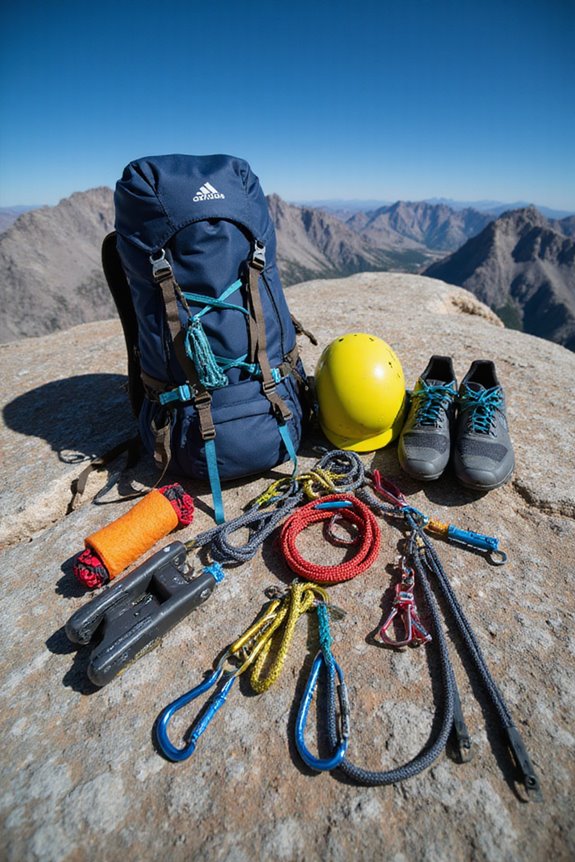
Selecting the right gear for mountain climbing is just as important as picking the perfect trail. We’ve gotta think about gear types tailored to various weather conditions. Layering is key, like a cozy sandwich! We need a moisture-wicking base layer, a warm mid-layer, and a waterproof outer shell to keep us dry and agile. And let’s not forget insulated gloves and sturdy mountaineering boots—they’re our best friends against frostbite. To ensure comfort on the climb, investing in waterproof hiking boots will help keep your feet dry and supported throughout your adventure.
For safety, a reliable helmet and the right ropes will make all the difference. But hey, don’t neglect navigation tools! A trusty GPS or map will guide us through craggy terrains. With the right gear, we’ll embrace the mountains with confidence and style—let’s conquer those peaks together!
Physical Training and Preparation
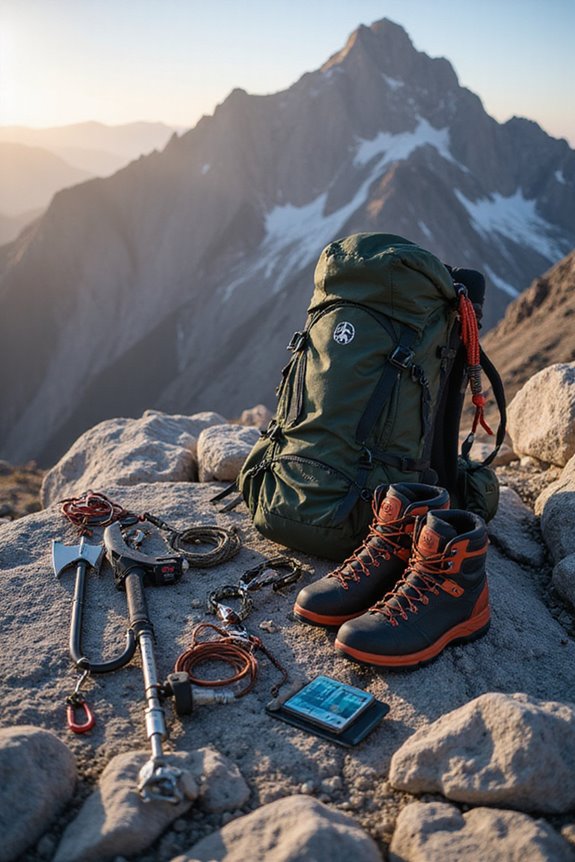
As we gear up for our mountain climbing adventure, physical training becomes our secret weapon for success! We’ll need to build our cardiovascular endurance through aerobic exercises like running and hiking; they’ll help us sustain energy over those long climbs. Let’s not forget about strength conditioning! Our legs need to power through steep terrain, so squats and lunges will be our best buddies. Plus, a strong core stabilizes us, preventing those pesky injuries. We can add some fun by doing hikes with weighted packs to simulate the climb. Additionally, having essential emergency gear on hand can enhance our safety during these challenging climbs. Remember, we’re in this together, and as we challenge ourselves, we’ll create not just strength but lasting memories. Let’s push our limits and embrace the exhilarating freedom of reaching new heights!
Planning and Logistical Considerations
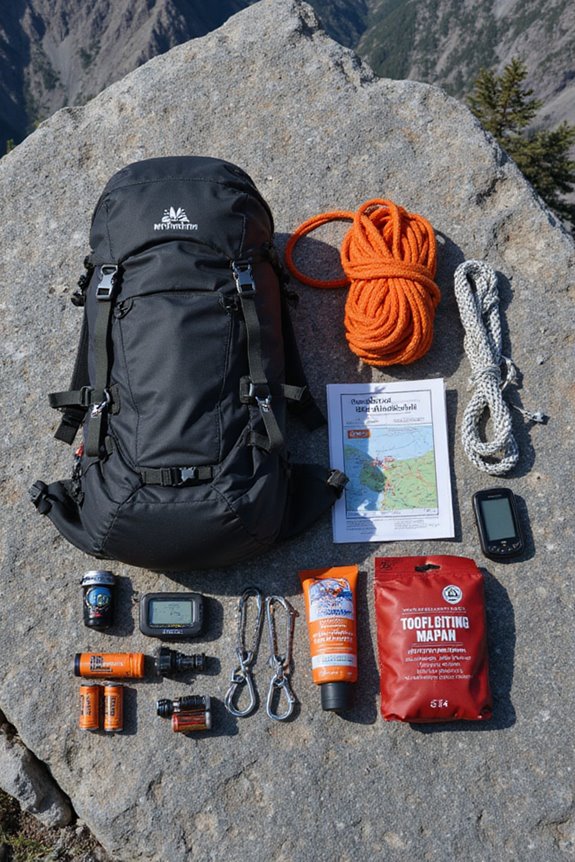
Having built our physical strength, let’s turn our attention to an essential aspect of our mountain climbing journey: planning and logistical considerations. First, we need to nail down our itinerary planning, mapping out daily mileage, elevation gains, and camp spots. It’s like creating our adventure roadmap!
We’ll keep an eye on weather monitoring too. Those forecasts can be as unpredictable as a squirrel on caffeine! So, let’s check conditions regularly to dodge surprises, like avalanches or sudden storms.
And, of course, we should share our finalized plans with someone back home—just in case, right? By blending meticulous planning with a pinch of spontaneity, we’ll embrace the freedom of the wild while keeping our adventure safe and enjoyable. Let’s go for it!
Mental and Safety Aspects

While we’re gearing up for our mountain climbing adventure, it’s essential not to overlook the mental and safety aspects that can make or break our experience. Developing mental resilience isn’t just a buzzword; it’s our survival tool. We can practice stress management techniques like mindfulness and visualization to tackle anxiety and improve focus. Picture yourself summiting that peak; it boosts our confidence!
Being adaptable is vital; mountain conditions change faster than we can say “avalanche!” Embracing flexibility prepares us for the unexpected. Plus, a strong team dynamic relies on trust and clear communication—because nothing says “teamwork” like yelling over wind gusts! So, let’s commit to mental preparation, keep our minds sharp, and conquer those mountains together! Additionally, having a reliable emergency survival kit on hand can enhance our safety and preparedness during the climb.
Frequently Asked Questions
How Do I Choose the Right Climbing Partner?
Choosing the right climbing partner’s all about trust factors and compatible communication styles. We need someone who shares our spirit of adventure, aligns with our goals, and is open for discussions about every climb we tackle together.
What Are the Best Climbing Destinations for Beginners?
When seeking beginner-friendly routes, we find scenic climbing spots like Big Cottonwood Canyon and Mount Fuji perfect. They offer accessible trails, beautiful views, and opportunities for adventure, allowing us to embrace our love for the mountains together.
How Can I Overcome My Fear of Heights?
To overcome our fear of heights, we can practice breathing techniques and visualization exercises together. By embracing these tools, we’ll gain confidence, feel more liberated, and ultimately enjoy the thrill of climbing without fear.
What Types of Climbing Styles Exist Beyond Traditional Climbing?
There’s a world of climbing styles beyond traditional methods! We can explore sport climbing for its routes and bouldering techniques that challenge our creativity. Each style offers unique freedom and adventure, inviting us to climb higher together!
How Do I Find Reputable Climbing Guides or Instructors?
Like traversing uncharted trails, finding reputable climbing guides requires trust. We can start by exploring online reviews and seeking local recommendations. These insights illuminate the path, leading us to experts who inspire our adventurous spirit.

